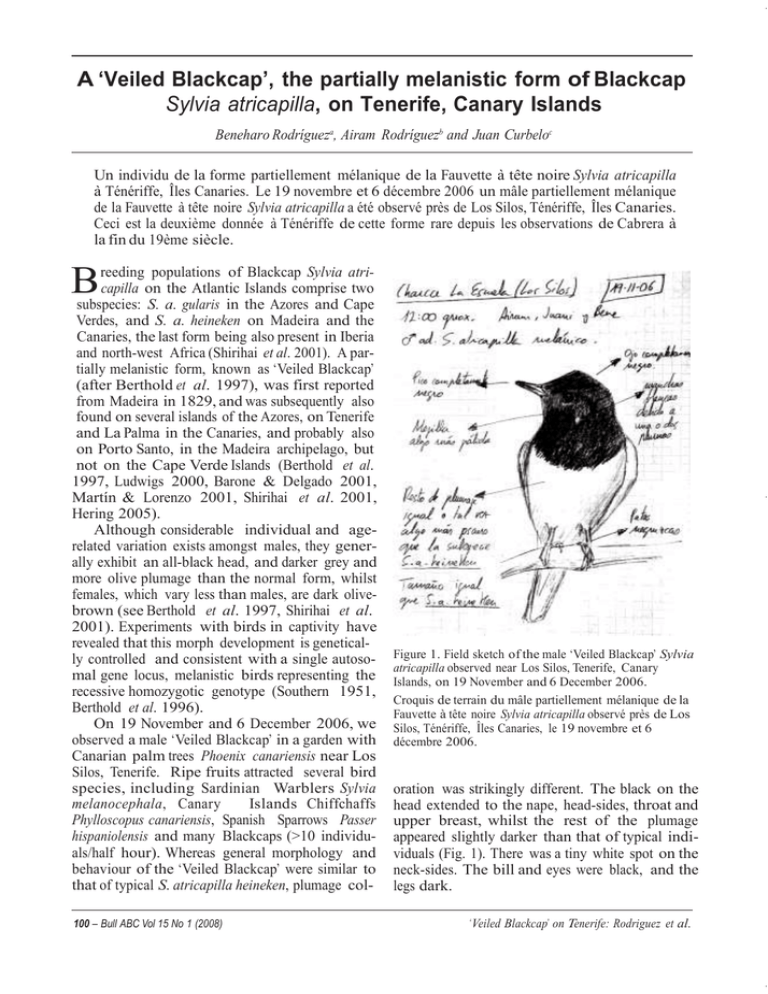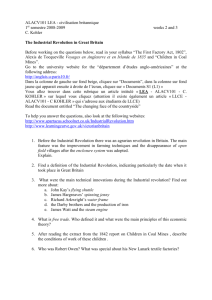rodriguez_et_al_2008_bull_abc.doc
advertisement

A ‘Veiled Blackcap’, the partially melanistic form of Blackcap Sylvia atricapilla, on Tenerife, Canary Islands Beneharo Rodrígueza, Airam Rodríguezb and Juan Curbeloc Un individu de la forme partiellement mélanique de la Fauvette à tête noire Sylvia atricapilla à Ténériffe, Îles Canaries. Le 19 novembre et 6 décembre 2006 un mâle partiellement mélanique de la Fauvette à tête noire Sylvia atricapilla a été observé près de Los Silos, Ténériffe, Îles Canaries. Ceci est la deuxième donnée à Ténériffe de cette forme rare depuis les observations de Cabrera à la fin du 19ème siècle. reeding populations of Blackcap Sylvia atricapilla on the Atlantic Islands comprise two subspecies: S. a. gularis in the Azores and Cape Verdes, and S. a. heineken on Madeira and the Canaries, the last form being also present in Iberia and north-west Africa (Shirihai et al. 2001). A partially melanistic form, known as ‘Veiled Blackcap’ (after Berthold et al. 1997), was first reported from Madeira in 1829, and was subsequently also found on several islands of the Azores, on Tenerife and La Palma in the Canaries, and probably also on Porto Santo, in the Madeira archipelago, but not on the Cape Verde Islands (Berthold et al. 1997, Ludwigs 2000, Barone & Delgado 2001, Martín & Lorenzo 2001, Shirihai et al. 2001, Hering 2005). Although considerable individual and agerelated variation exists amongst males, they generally exhibit an all-black head, and darker grey and more olive plumage than the normal form, whilst females, which vary less than males, are dark olivebrown (see Berthold et al. 1997, Shirihai et al. 2001). Experiments with birds in captivity have revealed that this morph development is genetically controlled and consistent with a single autosomal gene locus, melanistic birds representing the recessive homozygotic genotype (Southern 1951, Berthold et al. 1996). On 19 November and 6 December 2006, we observed a male ‘Veiled Blackcap’ in a garden with Canarian palm trees Phoenix canariensis near Los Silos, Tenerife. Ripe fruits attracted several bird species, including Sardinian Warblers Sylvia melanocephala, Canary Islands Chiffchaffs Phylloscopus canariensis, Spanish Sparrows Passer hispaniolensis and many Blackcaps (>10 individuals/half hour). Whereas general morphology and behaviour of the ‘Veiled Blackcap’ were similar to that of typical S. atricapilla heineken, plumage col- B 100 – Bull ABC Vol 15 No 1 (2008) Figure 1. Field sketch of the male ‘Veiled Blackcap’ Sylvia atricapilla observed near Los Silos, Tenerife, Canary Islands, on 19 November and 6 December 2006. Croquis de terrain du mâle partiellement mélanique de la Fauvette à tête noire Sylvia atricapilla observé près de Los Silos, Ténériffe, Îles Canaries, le 19 novembre et 6 décembre 2006. oration was strikingly different. The black on the head extended to the nape, head-sides, throat and upper breast, whilst the rest of the plumage appeared slightly darker than that of typical individuals (Fig. 1). There was a tiny white spot on the neck-sides. The bill and eyes were black, and the legs dark. ‘Veiled Blackcap’ on Tenerife: Rodriguez et al. This appears to be only the second record of this form on Tenerife, since the observations made by Cabrera (1893) at the end of the 19th century. On La Palma, where it was formerly locally common, this form has decreased dramatically, perhaps because it was a favoured local cagebird (Berthold et al. 1997, Martín & Lorenzo 2001, Shirihai et al. 2001), and it was searched for in vain by Cullen et al. (1952) and Morphy (1965); Bannerman (1963) suggested it was probably extinct. However, some 15 individuals have been sighted since the 1980s, the most recent in May 1999 (Ludwigs 2000, Martín & Lorenzo 2001). On Madeira and the Azores, on the other hand, this form was estimated to comprise c.2 % of the total population (Berthold et al. 1997). Acknowledgements Tony Clarke commented on the manuscript; Ron Demey made useful comments and improved an earlier version. References Bannerman, D. A. 1963. Birds of the Atlantic Islands. Vol. 1. Edinburgh & London, UK: Oliver & Boyd. Barone, R. & Delgado, G. 2001. Adiciones a la avifauna nidificante de la isla de Porto Santo (archipiélago de Madeira). Vieraea 29: 103–109. Berthold, P., Mohr, G. & Querner, U. 1996. The legendary “Veiled Blackcap” (Aves): a melanistic mutant with single-locus autosomal recessive inheritance. Naturwissenschaften 83: 568–570. Berthold, P., Mohr, G. & Querner, U. 1997. Die Schleiergrasmücke: Genetische Grundlagen, ‘Veiled Blackcap’ on Tenerife: Rodriguez et al. rezente Beobachtungen und historische Aspekte dieser melanistischen Form der Mönchsgrasmücke Sylvia atricapilla. J. Orn. 138: 135–170. Cabrera, A. 1893. Catálogo de las aves del Archipiélago Canario. Ana. Soc. Esp. Hist. Nat. 22: 1–70. Cullen, J. M., Guiton, P. E., Horridge, G. A. & Peirson, J. 1952. Birds on Palma and Gomera (Canary Islands). Ibis 94: 68–84. Hering, J. 2005. Erstnachweis einer “Schleiergrasmuecke” Sylvia atricapilla auf Flores, Azoren. Limicola 19: 217–224. Ludwigs, J.-D. 2000. Beobachtungen einer melanistischen Moenchsgrasmuecke (Sylvia atricapilla) auf der Kanareninsel La Palma. Vogelwarte 40: 234–235. Martín, A. & Lorenzo, J. A. 2001. Aves del archipiélago canario. La Laguna: Francisco Lemus. Morphy, M. J. 1965. Some birds of northeast La Palma, Canary Islands, August–September 1963. Ibis 107: 97–100. Shirihai, H., Gargallo, G. & Helbig, A. J. 2001. Sylvia Warblers. London, UK: Christopher Helm. Southern, H. N. 1951. Melanic Blackcaps in the Atlantic Islands. Ibis 93: 100–108. a La Malecita s/n, 38480 Buenavista del Norte, Tenerife, Canary Islands, Spain. E-mail: benerguez@terra.es b Estación Biológica de Doñana (CSIC), Pabellón del Perú, Avda. María Luisa s/n, 41013 Seville, Spain. c Ajoque 8, 38480 Buenavista del Norte, Tenerife, Canary Islands, Spain. . Bull ABC Vol 15 No 1 (2008) – 101
